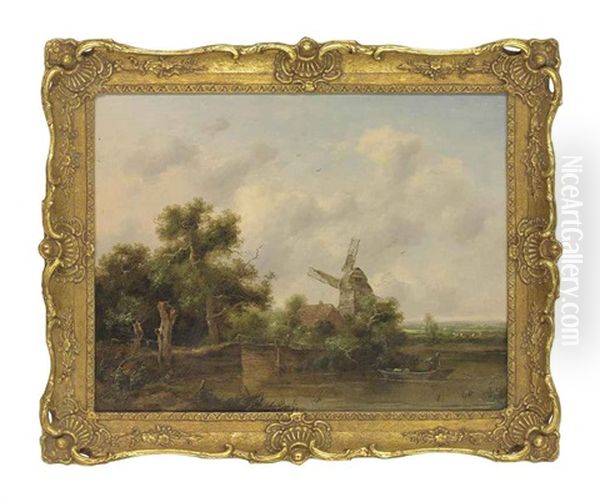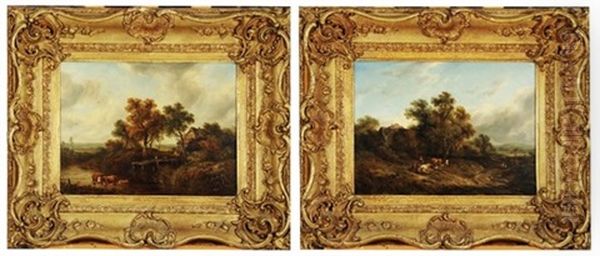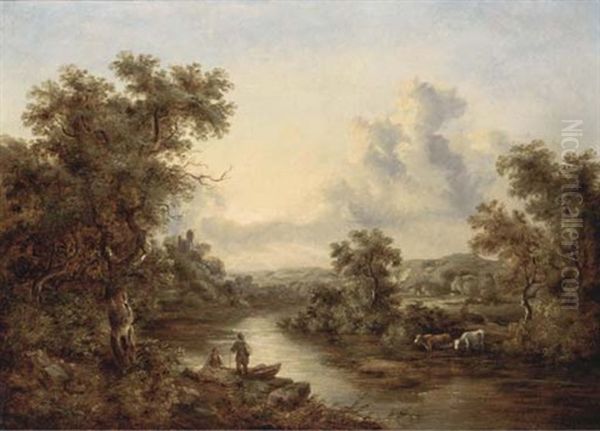Richard H. Hilder, an artist whose life spanned from 1813 to 1852, remains a somewhat enigmatic figure in the annals of British art history. Active during a vibrant period of artistic development in Britain, particularly in the realm of landscape painting, Hilder contributed to the rich tapestry of visual culture in the mid-19th century. His work, primarily in oils, captured the serene beauty of the English countryside, its rustic architecture, and the daily lives of its inhabitants. However, piecing together a comprehensive biography of Hilder is challenging, as detailed records of his life are sparse, and his identity has occasionally been muddled with other individuals bearing similar names, a point explicitly noted in some historical accounts. This article seeks to shed light on the artist Richard H. Hilder, his known works, his stylistic inclinations, and his place within the broader context of 19th-century British art, while also acknowledging the complexities surrounding his historical record.
The Challenge of Biographical Reconstruction
The primary challenge in discussing Richard H. Hilder (1813-1852) lies in the scarcity of definitive biographical information directly attributable to the artist. The provided source material itself highlights a significant point of confusion: it mentions a "Richard H. Hilder (1813-1852)" as a notable figure born in Tasmania, active in Burnie, who was a farmer and Methodist preacher, born on July 4, 1856. This date of birth (1856) directly contradicts the lifespan (1813-1852) attributed to the artist in the same document's heading and in references to his artwork. The document even states, "Richard H. Hilder’s birth date is July 1856," further compounding the discrepancy.

It is crucial, therefore, to distinguish between two potential individuals. The artist Richard H. Hilder, whose works are dated within the 1836-1852 period and who was active in London, aligns with the 1813-1852 lifespan. The other Richard H. Hilder, the Tasmanian farmer and preacher born in 1856, is a separate historical figure. The source material itself acknowledges this potential for confusion, stating, "It should be noted that 'Richard H. Hilder' mentioned in some evidence may be confused with other individuals of the same name." For the purpose of this art historical exploration, our focus will remain on the painter active in the mid-19th century, whose works provide the most tangible evidence of his existence and artistic practice. The anecdotes regarding the Tasmanian Hilder – his remarkable memory, his records of pioneer life, his involvement in transport in 1873, and his complex personality – belong to that distinct individual, not the artist under discussion here.
Artistic Career and London Context
Richard H. Hilder, the artist, is documented as being active in London between 1836 and 1852. This period places him squarely within a flourishing era for British art. London was the undisputed center of the British art world, home to the Royal Academy of Arts, the British Institution, and the Society of British Artists, among other exhibiting bodies. These institutions provided crucial platforms for artists to showcase their work, gain patronage, and establish their reputations. While specific records of Hilder's affiliations with these major societies are not detailed in the provided information, it is highly probable that he would have been aware of, and likely sought to engage with, this vibrant artistic milieu.
The mid-19th century saw landscape painting reach new heights of popularity and critical acclaim in Britain. Building on the legacy of earlier masters, artists of Hilder's generation continued to explore the diverse scenery of the British Isles and the atmospheric effects of its climate. The Industrial Revolution was transforming the physical and social landscape, leading some artists to seek solace and inspiration in the seemingly timeless beauty of the countryside, while others engaged with the changing world more directly. Hilder's choice of subject matter – river landscapes, rural scenes with farm animals, and figures within these settings – suggests an affinity for the pastoral tradition.
Notable Works and Stylistic Characteristics
Several works are attributed to Richard H. Hilder, offering insights into his artistic preoccupations and style. One of his key pieces is titled "A river landscape with a man punting, a windmill beyond." This oil painting, created between 1836 and 1851, measures 13¾ x 17¾ inches (45 x 44.5 cm). The imagery evoked by the title is quintessentially English: a tranquil river scene, the leisurely activity of punting, and the picturesque element of a distant windmill. Such compositions were popular, appealing to a taste for idyllic and harmonious representations of rural life. The painting was reportedly in the collection of Claudia Coates and was sold at Christie's in London on May 7, 1904, for £22.

Another significant work is "Landscape with House and Farm Animals," dated between 1836 and 1852. This piece was held in the Galerie Georges Petit. The inclusion of a house and farm animals suggests a focus on the settled, agricultural landscape, a theme deeply embedded in British art. These scenes often celebrated the productivity of the land and the perceived virtues of rural existence. A further painting, "Landscape with Figures," was sold in 1926, reinforcing his engagement with peopled landscapes.
While the provided texts do not offer an explicit description of Hilder's artistic style, we can infer certain characteristics. His medium was oil, and his subjects were natural landscapes, often featuring human activity and architectural elements. The period in which he worked was characterized by a general trend towards naturalism, though with varying degrees of romantic or picturesque sensibility. It is likely that Hilder's style involved careful observation of nature, attention to detail, and a concern for capturing light and atmosphere. The comparison made in the source to J.J. Hilder (a different artist known for watercolours and subjective colour harmonies) is more of a general reference to another artist named Hilder rather than a direct stylistic link to Richard H. Hilder's oil paintings. Richard H. Hilder's work would likely align more closely with the broader school of British landscape painters of his time, who valued verisimilitude combined with an aesthetically pleasing composition.
Thematic Focus: The British Landscape
The recurring themes in Richard H. Hilder's known works are centered on the British landscape, particularly its riverine and agricultural aspects. Riverscapes, like "A river landscape with a man punting, a windmill beyond," were a popular subgenre. Rivers were vital to commerce and daily life, and their meandering courses offered artists dynamic compositional possibilities. Windmills, like the one mentioned, were common features in many parts of the English countryside, particularly in flatter, agricultural regions, and added a picturesque, sometimes nostalgic, element to landscape paintings.

The depiction of "House and Farm Animals" points to an interest in the pastoral and the georgic – themes celebrating rural labor and the harmonious relationship between humans and the cultivated land. This was a tradition with deep roots, stretching back through artists like George Morland and finding renewed expression in the 19th century. Such scenes often resonated with a public that, even as industrialization progressed, held an idealized view of country life. The inclusion of figures, as in "Landscape with Figures," would have served to animate these scenes, providing narrative interest and a sense of scale. These figures were often depicted engaged in everyday rural activities, further grounding the paintings in a recognizable reality.
Artistic Influences and Contemporaries
Richard H. Hilder operated within a rich artistic ecosystem. The towering figures of British landscape painting from the preceding generation, John Constable (1776-1837) and J.M.W. Turner (1775-1851), had profoundly reshaped the genre. Constable, with his deep love for the Suffolk countryside and his commitment to capturing the transient effects of weather and light, championed a form of naturalism that was highly influential. Turner, on the other hand, pushed the boundaries of representation with his dramatic, often sublime, visions of nature and his innovative use of color and light. While Hilder's work, from the descriptions available, seems more aligned with the quieter, more conventional pastoralism than with Turner's high drama, the general emphasis on direct observation and atmospheric truth prevalent in the era would have been part of his artistic inheritance.
Among Hilder's contemporaries who were also dedicated to landscape painting, several names stand out. David Cox (1783-1859) was renowned for his vigorous watercolors and oils depicting the landscapes of Wales and England. Peter De Wint (1784-1849) was another master of watercolor, celebrated for his broad, tranquil views of the English countryside, particularly river scenes and harvest fields. Artists like Frederick Richard Lee (1798-1879) specialized in rustic British scenery, often collaborating with animal painters like Thomas Sidney Cooper. Thomas Creswick (1811-1869) was a popular landscape painter known for his pleasant depictions of English and Welsh river valleys and woodlands.
Other notable landscape artists of the period include William Shayer (1787-1879), who painted charming scenes of rural life, often featuring coastal areas and travelers, and John Linnell (1792-1882), whose earlier work included detailed pastoral landscapes before he turned to more visionary themes influenced by William Blake. William Collins (1788-1847) was popular for his coastal and rustic genre scenes. Marine and landscape painter Clarkson Stanfield (1793-1867) created dramatic and topographically accurate views. Later in the century, but part of the continuing tradition, artists like George Cole (1810-1883) and his son George Vicat Cole, as well as members of the Williams family of painters such as Sidney Richard Percy (1821-1886), continued to produce popular landscape views. Hilder's work would have been created and viewed alongside the output of these and many other artists, all contributing to the diverse panorama of 19th-century British landscape art.
The Hilder Enigma: Distinguishing Identities and Lost Details
As previously highlighted, the information surrounding Richard H. Hilder is complicated by the existence of another Richard H. Hilder from Tasmania, born in 1856. The source material explicitly mentions that the Tasmanian Hilder was a farmer and a Methodist preacher, known for his "excellent memory and detailed records of early pioneering life." It also notes that "his life details have mostly disappeared from records, making him a difficult figure to fully understand," and that "his books have further confused people's views of him." These details, including his involvement in transport activities in Mooreville in 1873 with his father Thomas senior and Thomas junior, and the description of his personality as "unique and conservative," with a mind "conveniently compartmentalized," clearly pertain to the Tasmanian individual, whose life (1856 onwards) post-dates the death of the artist Richard H. Hilder (1813-1852).
The anecdote about Hilder's character, described by an "Abelson" (this name is not commonly associated with art historical commentary on minor 19th-century British painters, and may relate to the Tasmanian Hilder), regarding his difficulty in remaining neutral between two friends he liked, further illustrates the type of personal detail that seems to attach to the Tasmanian figure rather than the London-based artist. The artist Richard H. Hilder remains known primarily through his artworks and the scant records of their sales or provenance. The "books" mentioned in relation to the Tasmanian Hilder, which supposedly confused his image, are not specified as art-related publications. This careful distinction is vital for an accurate art historical assessment of the painter.
Exhibitions, Sales, and Posthumous Recognition
The available information indicates that Richard H. Hilder's works did appear on the art market. The sale of "A river landscape with a man punting, a windmill beyond" at Christie's in London in 1904 for £22 is a concrete piece of data. Christie's was, and remains, a prestigious auction house, and the sale of a work there suggests a degree of market recognition, even if modest. The sale of "Landscape with Figures" in 1926 further supports this. The Galerie Georges Petit in Paris, which held "Landscape with House and Farm Animals," was also a significant gallery, known for exhibiting Impressionist and Post-Impressionist art, but also handling works from earlier periods.
The mention of an exhibition titled "CINEMA MACABRE" at the Beverly Perdue Art Center, scheduled for 2025, is intriguing. If Richard H. Hilder's work were to be included, it would likely be as part of a thematic exhibition exploring macabre or atmospheric elements in art across different periods, or perhaps a misattribution or a different artist named Hilder. Without further details, it's difficult to connect this directly to the historical artist's primary output of serene landscapes.
It is important to note that other exhibitions mentioned in the source material, such as the "J. J. Hilder Memorial Exhibition" (1916) and various shows featuring "J. J. Hilder and Contemporary Artists" in the 1980s, pertain to Jesse Jewhurst Hilder (1881-1916), an Australian watercolourist. While sharing a surname, J.J. Hilder is a distinct artistic personality from a different country and a later period, known for a different medium and style. This again underscores the need for careful differentiation when discussing artists named Hilder. For Richard H. Hilder (1813-1852), posthumous recognition seems to have been primarily through the circulation of his works in private collections and their occasional appearance at auction, rather than through dedicated retrospective exhibitions or extensive scholarly publications.
Art Historical Position and Evaluation
Based on the available evidence, Richard H. Hilder (1813-1852) can be positioned as a competent and diligent painter of the British landscape school active in the mid-19th century. His choice of subjects – river scenes, windmills, farmsteads, and rural figures – aligns with the prevailing tastes of the era, which favored picturesque and pastoral representations of the countryside. His works likely appealed to a middle-class clientele seeking pleasant and recognizable views of their national landscape.
He does not appear to have been an innovator in the same vein as Turner or Constable, nor is there evidence to suggest he was part of any radical artistic movements. Instead, his contribution seems to lie in his skillful rendering of conventional landscape themes, executed with a degree of sensitivity to the nuances of the British environment. The source material suggests his works "reflected the traditional style of British landscape painting of the time, rather than making groundbreaking or revolutionary artistic contributions." His artistic achievement, therefore, "may primarily lie in the faithful representation of natural landscapes and scenes of daily life."
The fact that his life details are obscure is not uncommon for artists who did not achieve the highest echelons of fame during their lifetime or posthumously. Many capable artists contributed to the artistic fabric of their time without leaving behind extensive biographical trails. Hilder's legacy, therefore, resides primarily in the surviving canvases that bear his name, offering quiet windows onto the British landscape as he perceived and depicted it nearly two centuries ago. His influence appears to have been "limited to specific art circles or collection areas."
Conclusion: An Artist of His Time
Richard H. Hilder (1813-1852) remains a figure who, while contributing to the tradition of British landscape painting in the mid-19th century, is shrouded in a degree of obscurity. His known works, such as "A river landscape with a man punting, a windmill beyond" and "Landscape with House and Farm Animals," depict serene and picturesque aspects of the English countryside, aligning with popular tastes of his era. He worked in London during a vibrant artistic period, alongside numerous contemporaries who were also dedicated to capturing the varied beauty of the British Isles.
The challenge in fully understanding Hilder is compounded by the limited biographical information available about him as an artist, and the potential for confusion with other individuals, notably a Richard H. Hilder from Tasmania with a different life story and timeline. By carefully sifting through the available data, we can appreciate the artist Richard H. Hilder for his contributions to the specific genre of landscape painting, recognizing him as a practitioner within a well-established tradition rather than a revolutionary figure. His paintings offer valuable, if modest, glimpses into the artistic preoccupations and visual culture of mid-19th century Britain, and serve as a reminder of the many artists whose stories are only partially told through the surviving fragments of their lives and works.